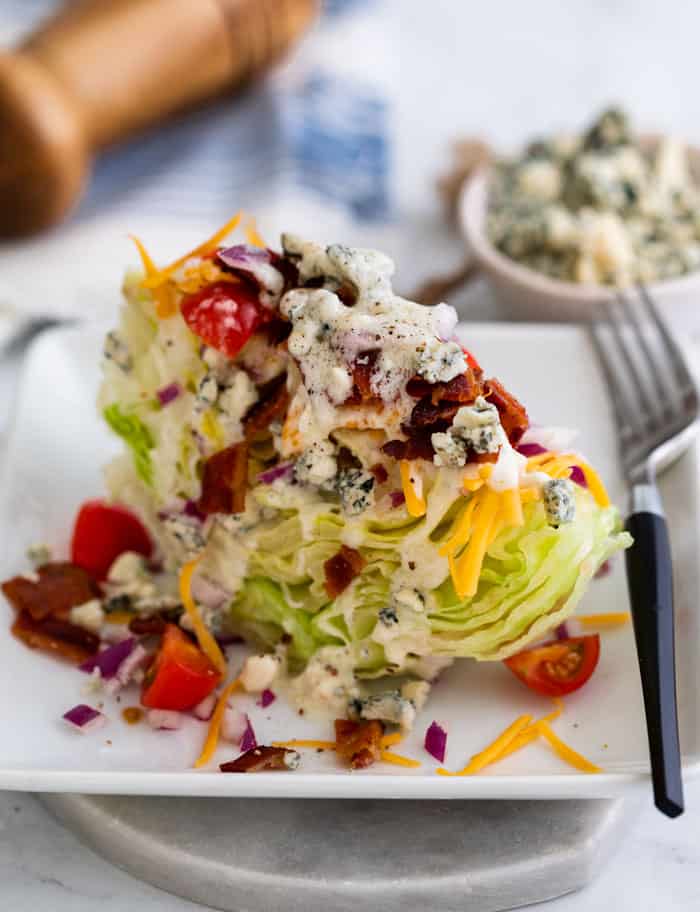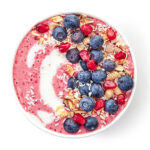The Wedge Salad is a classic American dish featuring a wedge of crisp iceberg lettuce topped with creamy blue cheese dressing, crumbled bacon, diced tomatoes, and often red onions. Its simple yet flavorful combination of ingredients and distinctive presentation make it a popular appetizer or side salad choice in the United States.
| Ingredients: | |
| 1 | 1 head of iceberg lettuce |
| 2 | 1/2 cup of blue cheese dressing |
| 3 | 1/4 cup of crumbled bacon |
| 4 | 1/4 cup of diced tomatoes |
| 5 | 2 tablespoons of chopped red onions |
| 6 | Optional: chopped chives for garnish |
Step-by-step cooking instruction of Wedge Salad:
Step-1 Prepare the Lettuce: Remove any outer leaves from the head of iceberg lettuce and discard. Cut the head of lettuce into quarters, making sure each wedge includes the core to hold the leaves together.
Step-2 Plate the Wedges: Place each lettuce wedge on a serving plate with the cut side facing up. This will create the classic wedge shape.
Step-3 Add Dressing: Drizzle the blue cheese dressing over each lettuce wedge. You can use as much or as little dressing as you prefer, depending on your taste.
Step-4 Top with Toppings: Sprinkle crumbled bacon, diced tomatoes, and chopped red onions over the dressed lettuce wedges.
Step-5 Garnish: If desired, add a sprinkle of chopped chives on top for added flavor and visual appeal.
Step-6 Serve: Serve the Wedge Salad immediately as an appetizer or side dish. The refreshing crunch of the iceberg lettuce combined with the creamy dressing and savory toppings creates a delightful taste experience.
Optional variations:
- Customize the toppings: Feel free to get creative with additional toppings like sliced hard-boiled eggs, avocado slices, or even grilled chicken or steak for a heartier version.
- Make your own dressing: If you prefer, you can make your own blue cheese dressing using ingredients like blue cheese crumbles, mayonnaise, sour cream, buttermilk, and seasonings.
Nutritional values of Wedge Salad:
The nutritional values of a Wedge Salad can vary based on factors such as the specific ingredients used and portion sizes. However, I can provide you with a general overview of the typical nutritional values for a classic Wedge Salad made with common ingredients:
Please note that these values are approximate and can vary based on the brand of ingredients and specific recipe variations.
Nutritional Values for a Classic Wedge Salad (approximate):
| Serving Size: 1 wedge of salad | |
| 1 | Calories: Approximately 200-300 calories |
| 2 | Macronutrients: Carbohydrates: Approximately 10-15 grams |
| 3 | Protein: Approximately 5-10 grams |
| 4 | Fat: Approximately 15-25 grams |
| 4 | Dietary Fiber: Approximately 2-4 grams |
| 5 | Sodium: Approximately 500-800 milligrams (may vary based on dressing and bacon) |
| 6 | Vitamins and Minerals: The salad can provide some vitamins and minerals, especially vitamin A from the lettuce and tomatoes, and calcium and phosphorus from the blue cheese dressing. The bacon and dressing may also contribute to the sodium content. |
Background History of Wedge Salad:
The exact origins of the Wedge Salad are not well-documented, but it is generally believed to have emerged in mid-20th century America. The salad’s creation is often attributed to the rise of the steakhouse culture and the popularity of classic American cuisine during this time.
Several factors contributed to the development of the Wedge Salad:
Iceberg Lettuce Popularity: In the mid-20th century, iceberg lettuce was widely available and relatively inexpensive. Its crispy texture and mild flavor made it a popular choice for salads, and its large, round head lent itself well to being cut into wedges.
Blue Cheese Dressing: The creamy and tangy blue cheese dressing that typically accompanies the Wedge Salad became more widely available and popular during this era. Its strong flavor paired well with the mildness of iceberg lettuce, creating a satisfying contrast.
Steakhouses and American Cuisine: During the mid-20th century, steakhouses and classic American restaurants were gaining popularity. The Wedge Salad’s simple yet indulgent nature made it a fitting appetizer or side dish for these establishments.
Visual Appeal: The distinctive presentation of the Wedge Salad, with its wedge-shaped iceberg lettuce and generous toppings, added to its visual appeal. This unique presentation likely contributed to its enduring popularity.
While the Wedge Salad’s exact origin story may be elusive, its popularity grew steadily over the decades, becoming a staple on menus across the United States. Despite its simple ingredients, the Wedge Salad’s combination of flavors and textures has made it a beloved classic that continues to be enjoyed by diners today.
| Advantages of Wedge Salad | |
| 1 | Simple and Classic: The Wedge Salad’s straightforward combination of ingredients is a classic and timeless choice that appeals to a wide range of tastes. |
| 2 | Distinctive Presentation: The unique wedge shape of the salad, along with the arrangement of toppings, creates an appealing visual presentation that can enhance the dining experience. |
| 3 | Texture Contrast: The crispy texture of iceberg lettuce, creamy dressing, and crunchy toppings like bacon and onions provide a satisfying contrast of textures. |
| 4 | Customizable: While the basic components are consistent, the Wedge Salad can be customized with various toppings and dressings to suit individual preferences. |
| 5 | Refreshing: The high water content of iceberg lettuce offers a refreshing and hydrating quality to the salad. |
| 6 | Satisfying Appetizer or Side: The Wedge Salad can serve as a light appetizer or a flavorful side dish, complementing a variety of main courses. |
| 7 | Nostalgic Appeal: The Wedge Salad’s status as a classic American dish can evoke feelings of nostalgia and comfort. |
| Disadvantages of Wedge Salad | |
| 1 | Nutritional Profile: The salad’s high fat and calorie content, particularly from ingredients like bacon and blue cheese dressing, can be a concern for individuals seeking healthier options. |
| 2 | Limited Nutrient Variety: While iceberg lettuce provides some vitamins and minerals, the salad may lack the nutrient diversity offered by a wider range of vegetables. |
| 3 | Sodium Content: The presence of bacon and blue cheese dressing can contribute to a higher sodium content, which may be an issue for those watching their sodium intake. |
| 4 | Food Safety: If not handled or stored properly, ingredients like raw tomatoes, eggs, or dressing may pose food safety risks. |
| 5 | Potential Allergens: Blue cheese dressing may contain allergens like dairy, and bacon may be a concern for those following specific dietary restrictions. |
| 6 | Limited Protein: The protein content of the salad may be relatively low, especially if not accompanied by additional protein sources. |
| 7 | Environmental Impact: The use of iceberg lettuce, which has a relatively low nutritional yield compared to other greens, can contribute to higher resource consumption in terms of water and energy. |
| 8 | Price: The cost of ingredients like blue cheese and bacon can make the Wedge Salad relatively expensive compared to other salad options. |
Compare with Similar meal of Wedge Salad:
If you enjoy the flavors and elements of a Wedge Salad but are looking for similar meal options, here are a few dishes that share some characteristics with the Wedge Salad:
| 1 | Cobb Salad: The Cobb Salad is another classic American salad that typically features mixed greens topped with a variety of ingredients, including diced chicken, crumbled bacon, hard-boiled eggs, avocado, tomatoes, and blue cheese. It offers a combination of textures and flavors similar to the Wedge Salad. |
| 2 | BLT Sandwich: A BLT (Bacon, Lettuce, and Tomato) sandwich incorporates some of the key elements of the Wedge Salad. Crispy bacon, lettuce, and tomato are sandwiched between slices of bread, often with the addition of mayonnaise. You can use whole-grain bread for added nutrients. |
| 3 | Steakhouse Salad: Many restaurants offer variations of a steakhouse salad that combine grilled steak with mixed greens, tomatoes, onions, and sometimes blue cheese dressing. This can provide a heartier option while maintaining some of the classic flavors. |
| 4 | Chopped Salad: A chopped salad typically includes a medley of chopped vegetables, greens, and proteins. You can create your own version by incorporating ingredients like lettuce, tomatoes, onions, bacon, cheese, and a tangy dressing. |
| 5 | Grilled Chicken Salad: A grilled chicken salad combines tender grilled chicken with a variety of fresh vegetables, often accompanied by a flavorful dressing. You can include lettuce, tomatoes, bacon, and blue cheese to capture some of the Wedge Salad’s essence. |
| 6 | Avocado BLT Salad: This salad combines the creamy richness of avocado with the classic BLT ingredients of bacon, lettuce, and tomato. You can add blue cheese crumbles or another tangy cheese for extra flavor. |
| 7 | Chicken Caesar Salad: While not exactly the same as a Wedge Salad, a Chicken Caesar Salad features romaine lettuce, grilled chicken, croutons, Parmesan cheese, and Caesar dressing. The combination of crisp lettuce and creamy dressing offers a satisfying contrast. |
| 8 | Spinach Salad with Warm Bacon Dressing: This salad features spinach leaves topped with a warm bacon vinaigrette dressing. While the base is different, the combination of greens, bacon, and a flavorful dressing may appeal to Wedge Salad enthusiasts. |
Mostly questions asked about Wedge Salad
1: What is a Wedge Salad?
A: A Wedge Salad is a classic American salad featuring a wedge-shaped piece of iceberg lettuce topped with blue cheese dressing, crumbled bacon, diced tomatoes, and often red onions.
2: Why is it called a Wedge Salad?
A: The salad is called a “Wedge Salad” due to the unique presentation of a quarter head of iceberg lettuce, cut into a wedge shape.
3: What kind of dressing is used for a Wedge Salad?
A: The traditional dressing for a Wedge Salad is creamy blue cheese dressing. However, you can also find variations with other dressings like ranch or balsamic vinaigrette.
4: Can I use a different type of lettuce for a Wedge Salad?
A: While iceberg lettuce is traditional, you can experiment with other lettuce varieties. However, the crispy texture of iceberg lettuce is a defining characteristic of the salad.
5: What toppings can I add to a Wedge Salad?
A: Common toppings include crumbled bacon, diced tomatoes, chopped red onions, and sometimes chopped chives. Additional toppings like hard-boiled eggs, avocado, or grilled chicken can be added for variation.
6: Is a Wedge Salad healthy?
A: A Wedge Salad can be part of a balanced diet, but it’s important to be mindful of portion sizes and dressing choices due to its calorie and fat content. You can make it healthier by using lighter dressings and incorporating more vegetables.
7: Can I make a vegan or vegetarian version of a Wedge Salad?
A: Yes, you can create a vegan Wedge Salad by using plant-based alternatives for bacon and cheese and opting for a vegan dressing. For a vegetarian version, you can simply omit the bacon.
8: Is a Wedge Salad a meal or a side dish?
A: A Wedge Salad can be served as either a light meal on its own or as a flavorful side dish accompanying a main course.
9: Can I make a gluten-free Wedge Salad?
A: Yes, a Wedge Salad is naturally gluten-free as long as the dressings and toppings used do not contain gluten. Be sure to check ingredient labels.
10: Can I prepare a Wedge Salad ahead of time?
A: While the lettuce is best served fresh, you can prepare the dressing, toppings, and other components ahead of time and assemble the salad just before serving to maintain the crispy texture of the lettuce.







